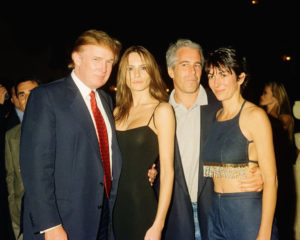This article was originally published on August 11, 2021.
What’s the point of Prince Andrew? I don’t ask this only to be cruel, although there is an obvious cruelty in suggesting that an actual person might be pointless. But Prince Andrew isn’t just a person — he’s also a prince, elevated by birth to a strange prominence in an institution that turned out to have no need of him.
He’s the redundant spare, not even useful for making dynastic alliances, since there are no royal houses left worth allying with; and anyway, diplomacy by human meat market was out of fashion before he was born. He doesn’t even have the dignity of being a working royal, since 2019 when he stepped back from all public duties over his “association” with the late sex trafficker and financier Jeffrey Epstein.
Although Prince Andrew remains close to the Queen, the exact nature of that “association” continues to hang rancidly over the royal family. Was he just hanging around with Epstein, or did he — as Epstein victim Virginia Roberts Guiffre states in a lawsuit filed on Monday — take part in the sexual abuse of teenage girls? Was he somehow ignorant of everything he was adjacent to, or actually corrupt? Stupid, or degenerate? (Prince Andrew denies Guiffre’s claims.)
There’s a photo of Prince Andrew from 2001 with then 17-year-old Guiffre. She beams at the camera, long blonde hair hanging below her collarbone and a flash of midriff exposed; he stands side-on, arm around her waist, adult fingers touching bare childish skin, an expression of dazed expectation on his face like a man who can’t believe his luck. And in the background, Epstein’s girlfriend Ghislaine Maxwell, who allegedly groomed and recruited the girls (Maxwell denies this), smiling happily — the smile of a complacent friend or a satisfied madam, depending on what you choose to read into it.
Prince Andrew’s response to this photo has been to suggest that it has been “doctored”, claiming: “I am not one to, as it were, hug.” (Pictures of him taken at various nightclubs suggest that he is very much one to, as it were, hug.) As defences go, it’s only marginally less hard to swallow than the Pizza Express alibi or the claim he cannot sweat. Still, you can understand his desperation to argue it away: twenty years on, the picture looks grotesque, his age an obscenity next to Guiffre’s youth.
Would it have looked that way at the time it was taken? The millennium was a strange, unsettled moment for talking about girls and sex. On the one hand, the tabloids had picked out paedophiles as the villains of the moment (the apotheosis of this came in 2000, when a paediatrician’s home was vandalised with graffiti reading “paedo”: police confirmed that the perpetrators had confused the job with the crime). On the other, the titillating concept of the “barely legal” girl was firmly established in pornography and spilling over into popular culture.
And at the same time, the American evangelical movement had been doing its part for the fetishisation of virginity by promoting “abstinence-only” education and coaxing teens into wearing “promise rings” that showed their commitment to no sex before marriage. Britney Spears wore one: it seemed to be taken less as an assertion of her innocence than as a provocation to those who fantasised about despoiling her.
In 2000, a businessman allegedly offered Britney $7.5m for the honour of deflowering her. Two years later, the DJ Chris Moyles was chatting about another teenage singer’s virginity on his Radio 1 show: on the day Charlotte Church turned 16, he volunteered to “lead her through the forest of sexuality”. (Moyles was censured by the Broadcasting Standards Commission, but he kept his job.)
The physical ideal of the late twentieth century and early noughties was nymphet-esque — slim hips, pert tits and, most important of all, a set of taut and unstretchmarked abdominals to make clear that all fecundity was as yet untested. The line of girl and woman was blurred and blurred again. In an early Kate Moss photoshoot that I’d see regularly on halls of residence walls later, the then sixteen-year-old model wears nothing but black knickers, stockings and heels, and holds a teddy bear to cover her breasts.
The taboo on underage sex was strong enough to make the idea of breaking it exciting, and no stronger. Even the wholly un-edgy indie band Travis (a kind of John the Baptist before Coldplay’s arrival as the Jesus of inoffensive guitar music) had a song called “U16 Girls”.
Prince Andrew now denies that he visited West End nightclub Tramps with Guiffre. But if he’d been there in the late 80s, he could have shared the dancefloor with Rolling Stone Bill Wyman and his girlfriend Mandy Smith — she was thirteen when they got together, and he was 47. When the relationship became public after she reached the age of consent, it was treated as a joke rather than a sex offence, with him the randy old man and her the canny little starfucker. Friends of the couple from that era look back and feel ashamed for turning a blind eye, but still, they turned a blind eye.
When, in 2012, the extent of Jimmy Savile’s predations became obvious and the complicity of the BBC undeniable, journalist Rachel Cooke wrote this in the Observer:
“Our outrage, in truth, has little to do with any institution, however remiss. It’s born of bewilderment that something so terrible could be in plain sight. Why, we wonder, did we not notice? Yet even this idea, if you unpick it, is kind of phoney.”
What Savile was had always been obvious. But for decades, it was seen as an ugly but acceptable peccadillo for a man to have sex with a girl. And then, one day, it wasn’t seen that way at all anymore.
How we think about age, power and sex has changed immeasurably over the last decades. When I saw the revival of David Mamet’s sexual harassment drama Oleanna — currently running in London — it seemed flat, despite the sparring dialogue. In 1992, when the play debuted, audiences saw genuine ambiguity in the relationship between a professor and his wounded female student. Did he cross the line? Was she coaxed into seeing herself as a victim of campus politics?
In 2021, the moment he steps up behind her and places his hands on her shoulders, he’s lost. We know, now, that a tutor doesn’t touch a student that way. Even if she’s technically an adult, her comparative youth and institutional inferiority are blatant. The violation is unarguable.
What a shock, I suppose, to be one of the men around whom this cultural shift took place. To be, say, Jeffrey Epstein, who in 2008 used a plea bargain to wriggle out of being prosecuted for procuring a minor for prostitution, and was able to return to his life of wealth and high-rolling connection, until in 2019 he found himself imprisoned and facing a similar set of charges all over again.
The taint of connection with Epstein spilled out, with Prince Andrew alongside Bill Gates and the former CEO of Victoria’s Secret in the list of those whose reputations have turned to dirt. Epstein’s suicide hastened the civil suits such as the one against Prince Andrew, which would otherwise have had to wait for the criminal trial to conclude. It also made them more urgent: from the perspective of Epstein’s victims, with him dead, they must look to the living for someone to hold accountable. For Guiffre, suing Prince Andrew is the next best thing to justice.
So maybe this will be the point of Prince Andrew. His relationship with Epstein, and its transformation from something that could be winked at to something that could potentially soil the entire royal family, could prove to be a measure of the change in his lifetime. There’s plenty still that’s grim in the treatment of girls, but at least today if someone were to be proven to have knowingly had sex with a trafficked teenager — even if that someone was a prince — there’d be no laughing it off.
Disclaimer
Some of the posts we share are controversial and we do not necessarily agree with them in the whole extend. Sometimes we agree with the content or part of it but we do not agree with the narration or language. Nevertheless we find them somehow interesting, valuable and/or informative or we share them, because we strongly believe in freedom of speech, free press and journalism. We strongly encourage you to have a critical approach to all the content, do your own research and analysis to build your own opinion.
We would be glad to have your feedback.
Source: UnHerd Read the original article here: https://unherd.com




